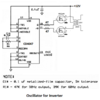I see everywhere a multivibrator connected toa transformer for an inverter.

question is let say I want to change the frequency from 60 hz to higher or lower do I just chuck in a variable resistor and if so instead of which resistor?
also I was thinking of more amps, do I just put more mosfets in parallel or make 1 circuit for each?
disclaimer the transformer will be 48 volt on the out side not 230.

question is let say I want to change the frequency from 60 hz to higher or lower do I just chuck in a variable resistor and if so instead of which resistor?
also I was thinking of more amps, do I just put more mosfets in parallel or make 1 circuit for each?
disclaimer the transformer will be 48 volt on the out side not 230.

